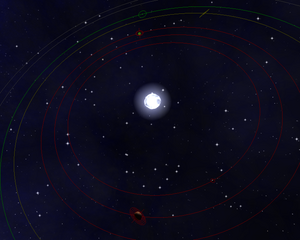Solar System

Sectors contain solar systems. The number of solar systems in each sector is based on the star density at the sector's coordinate in the galaxy.
Solar systems contain one, two or three stars. The primary star is at the center of the solar system. In a binary or trinary system, the secondary star orbits the primary star. In a trinary system, the tertiary star may orbit the primary or it may orbit the secondary.
Planetary Bodies
Stars usually have planetary bodies orbiting them. Solar output (based on the spectral classification and magnitude of each star) determines the radius at which the habitable orbit zone may occur. In this orbit zone, worlds may be habitable. Not all solar systems contain habitable worlds. Some solar systems have no planetary bodies at all.
All planetary bodies orbit in a completely circular orbit around the host star or world. Each world may have up to four moons and planetary rings.
See also: Planetary System
Interstellar Travel
It is possible for a spacecraft to travel through space directly to another solar system at lightspeed using normal propulsion, this is known as deadheading and travel time can be quite long depending on the distance. A spacecraft with a FTL drive can however travel the same distance in a fraction of the time.
Wormholes
The primary star may have one or more naturally occurring wormholes present around it. Wormholes connect to nearby solar systems in a loose branching network. Spacecraft use wormhole drives to travel instantly from one solar system to another through wormholes.